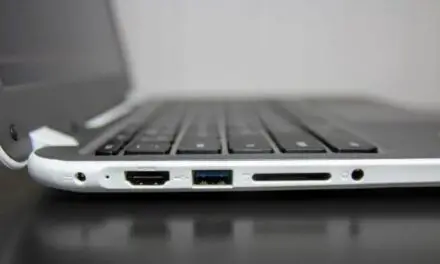The Chromebook has taken a massive bite out of the PC market by meeting consumer demand for something that rests comfortably in between a full-fledged PC and mobile technology.
But since Chromebooks aren’t powerhouse PCs, are they useful for things like distance learning?
Chromebooks are excellent for online or distance learning. In fact, the sales of Chromebooks skyrocketed during the early and middle stages of the Coronavirus pandemic, despite what the current market downtrend says.
So long as you aren’t looking into graphics-intensive games or learning that involves serious design or creative work, a Chromebook is more than capable of delivering an educational experience through school applications (online classes), video conferencing, web browsing, spreadsheets, and word processing.
Distance learning can be problematic in terms of needing something that can fully replace a physical learning environment and do so in a dependable and long-term fashion.
Chromebooks, having existed since 2011, stepped in to neatly fill that void for a variety of good reasons.
Here are 9 reasons why Chromebooks are great for distance learning:
Table of Contents
Chromebooks Are Lightweight And Portable For Studying On The Go

One of the appealing aspects of a Chromebook is the portability factor.
These aren’t gigantic laptops but neither are they something that you can slip into your pocket when you’re through.
Distance learning is often an on-the-go process and a Chromebook plays the perfect, portable role.
Chromebooks are exceptionally lightweight yet the hardware is robust enough to perform a variety of education-related tasks with great efficiency.
Thanks to the efficient and lightweight nature of Chrome OS, Chromebooks usually don’t have a need for cooling fans or heavy and powerful components.
They can work perfectly well on lightweight hardware that does not get hot.
This allows Chromebook to be built light.
They’re also appealing for how easy they are to set up with a mobile hotspot, whether it’s through a smartphone or a MiFi hotspot provided by the carrier.
The combination of technologies effectuates a high level of portability and on-the-go functionality.
Chromebooks Are Fast, Allowing You More Time for Learning
Chromebooks power up and shut down in seconds. They also update faster than other laptops and are very fast to open up web pages and applications.
When you only have a short time to study, a speedy device can make all the difference.
Gone are the days of opening up a laptop and waiting for an age for the username and login screen to pop up, followed by another head-scratchingly lengthy period before you can start using your laptop.
The ChromeOS (Chromebook Operating System) is not a convoluted nightmare of background processes and start-up tasks that mire your ability to work in lengthy load times and glitchy start-ups.
When you open your Chromebook, it’s as close to a smartphone or tablet-like experience as you can get in what amounts to a speedy laptop.
As such, you have more time to focus on learning.
Robust Security, Right Out of the Box
The Chrome Operating system provides several layers of security, which includes the fact that it is not a convoluted OS.
The more complex an OS, the more vulnerabilities they have because there are more vectors for attack.
The system and security updates roll in routinely, mostly in the background, keeping the Chrome OS caught up when it comes to the latest vulnerabilities.
The safe boot feature and software designed to focus on and avoid malware make the Chromebook an exceptionally safe device.
Its weaknesses are in the extensions, so it pays to be alert when it comes to adding extensions to your Chrome browser.
Only download popular, official extensions that have lots of good reviews.
A Host Of Available Education Apps In The Cloud
If it’s not already there, you can find it with a Google Chromebook.
Chromebooks already come with a ton of software that is tailor-made for educational purposes, including Google Docs, Meet, Drive, Workspace, Gmail, Hangouts, and more.
If you can’t find what you’re looking for on Google Workspace, then the odds are, that you either don’t need it or it doesn’t exist.
However, if you’re doing an advanced course in accounting or mathematics that may require you to download specific applications onto your device, a Chromebook may not be able to do it.
Always check first with your course provider to find out if a Chromebook will be good enough.
You Might Also Like: 14 Reasons Why Chromebooks Are Great For Elderly People
Exceptional Battery Life
Since most Chromebooks don’t delve too heavily into the sophisticated software and hardware side, they have the advantage of offering exceptional battery longevity between charges.
While all Chromebooks have great battery life, there are a few that really stand out.
- Samsung Chromebook 3: Nearly 10 hours
- Lenovo ThinkPad C13: 8 hours +
- Asus Chromebook CM3: 12 hours
- Acer Chromebook Spin 713: 11 hours +
- Lenovo Chromebook Duet: 13 hours
With the average battery life of a laptop riding between 1 and ½ to 4 hours, it’s easy to see the attraction that the long battery life of a Chromebook can offer for those who are engaged in distance learning.
Free Cloud Storage With All New Chromebooks
One drawback to Chromebooks is their limited storage capabilities, which is completely understandable considering the focus on lightweight portability.
However, when it comes to education, you can run out of storage space fast.
Thankfully, anyone who purchases a new Chromebook, regardless of manufacturer, gets a free year of 100GB worth of Google Cloud Storage.
That’s a lifesaver, especially considering that some Chromebooks will come with as little as 25GB of internal storage.
In today’s day and age, you can burn through that amount of storage in just a few 4k videos, so imagine what you could do over two semesters.
Access To Google Play Store Apps On Newer Chromebooks
The Google Play Store is an important part of Android devices since that’s where all of the fun is.
It’s also where thousands of educational apps reside and with newer model Chromebooks, you now have access to these apps on the Google Play Store.
The Google Play Store is an invaluable tool in distance learning simply because of all of the available education apps.
Plus, administrators or teachers who integrate new apps into their curriculum can now share those apps with students for quick access.
You Don’t Need to Buy Additional, Expensive Software
The beauty of a Chromebook for distance learning is that the device is an “all-in-one” tool.
Once you have your Chromebook, you will have all you need to fully engage with your teachers, administrators, and the student body without having to fork over a substantial investment in additional software.
Chromebooks are cheaper Than Traditional Laptops
The average cost of a laptop is between $600 and $700, while the average cost of a Chromebook is between $250 and $350.
Going for a Chromebook as a primary tool for distance learning makes a lot more sense where your wallet or purse is concerned.
Laptops are focused all over the place, packing in the latest and most relevant technology that can compete in a more gaming, streaming, and high tech world.
However, Chromebooks have been designed to be fast-performing devices with internet access at the forefront, making it far easier to focus on what you need to do in terms of your education.
Which Chromebooks are Best for Distance Learning?
Chromebooks are popular but not all models produced each year are suitable for distance learning.
Some Chromebook models are high-end and come with powerful components, 4K touchscreens, backlit keyboards, and even internal cooling fans.
High-end models can be expensive, bulky, and suffer from poor battery life, due to their ultra HD touchscreens.
But the main issue with high-end Chromebooks is the price.
If you’re going to be spending over $800 to $1,000 on a Chromebook, there are some very capable Mac and Windows laptops for around that price range.
And a capable Windows or Mac device is going to be much more diverse and offer you much better value for money when compared to a similarly priced Chromebook.
Very expensive Chromebooks usually aren’t the best for distance learning but the very cheapest of Chromebooks might not be suitable either.
Many budget Chromebooks can have very poor build quality, very limited memory and screens so dim that they would be hard to see in anything other than a dark room.
Going too cheap or too expensive could easily land you with a Chromebook that you’ll regret buying.
Here are a couple of Chromebooks that don’t fall into either category and are a great fit for distance learning.
Lenovo IdeaPad Duet Chromebook
A good budget Chromebook.
The IdeaPad Duet has a capable MediaTek processor, 4 GB of LPDDR4X RAM, a 10.1 inch full HD touchscreen with 400 nits of brightness, and 64 GB of eMMC storage.
It’s a lightweight and affordable device that can go for a long time on a single charge.
Remember when tablets were going to take over the world? With the Lenovo IdeaPad Duet Chromebook that might still happen!
It uses a snap-on keyboard that is ideal for students and distance learning – providing both easy tablet use and more powerful laptop features when you need them.
Asus Chromebook Flip C436
A decent premium Chromebook.
The Chromebook Flip has an Intel Core i3 processor, a generous 8GB of RAM, a 14-inch Full HD screen, and 128GB of SSD storage.
The Asus Flip has a solid build quality and Is a powerful performer for when you want to do some multitasking or have lots of coursework to get through.
Chromebooks can be a great option for distance learning on a budget but speak to your course provider first to ensure that a Chromebook can do everything required of the course you’re planning to undertake.
But If your budget is creeping up into the price ranges of capable Windows and Mac laptops, you should definitely consider one of those.



